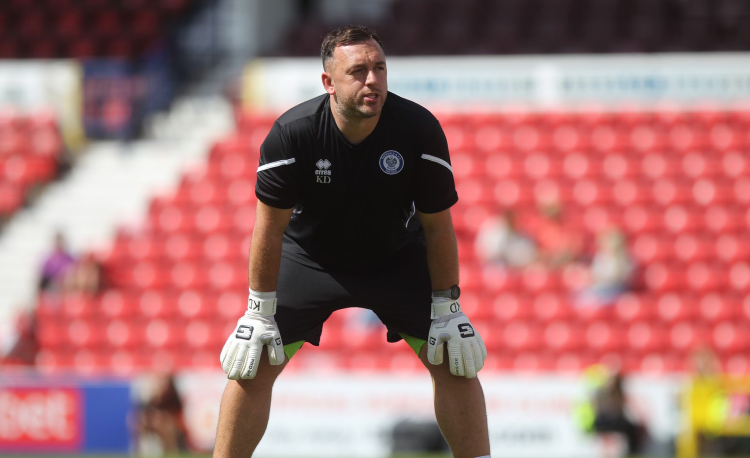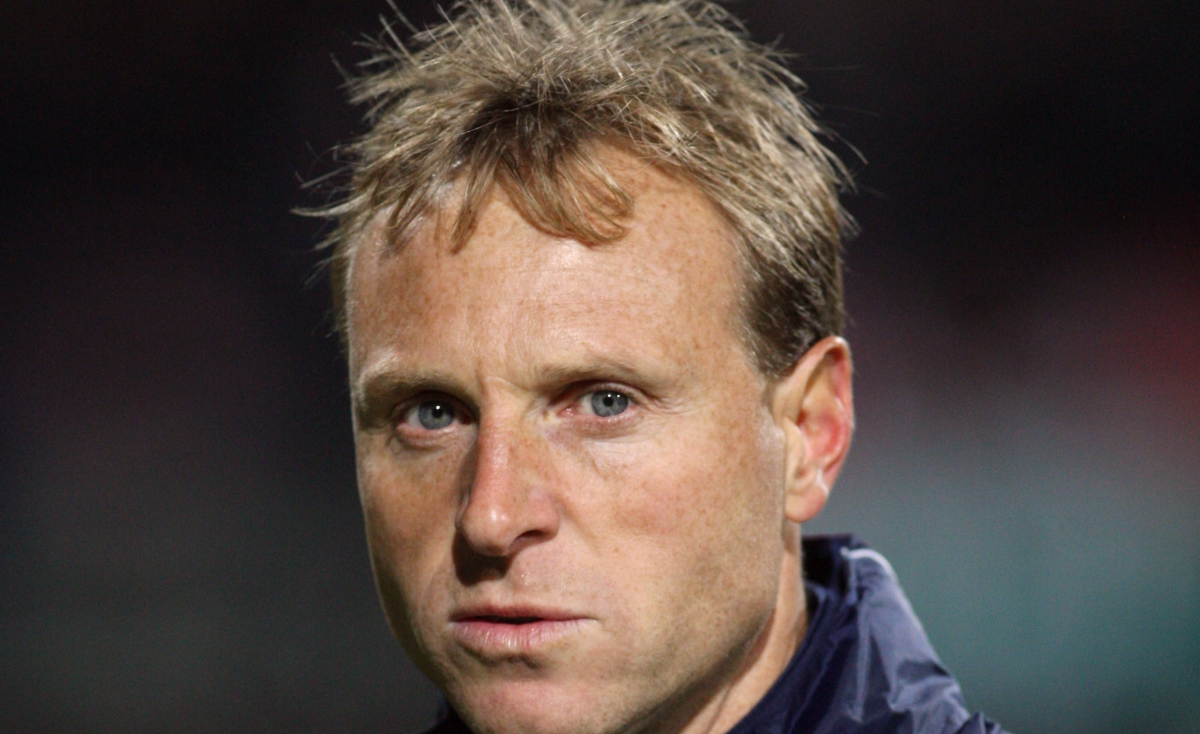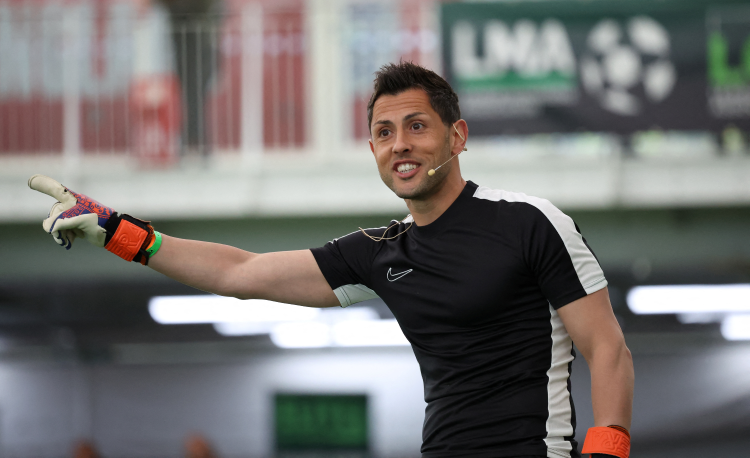




OUR BEST EVER OFFER - SAVE £100/$100
JOIN THE WORLD'S LEADING PROFESSIONAL DEVELOPMENT PROGRAMME
- 12 months membership of Elite Soccer
- Print copy of Elite Player & Coach Development
- Print copy of The Training Ground
Goalkeeper out of possession: defending the goal centrally from 0-12 yards
The session is focused on the goalkeepers utilising the most effective technical choices.
| Area | Up to 28x24 yards |
| Equipment | Balls, cones, full size goals |
| No. of Players | 4 goalkeepers |
| Session Time |
Technical-focused activation and semi-live practice combined: 20mins |
The session is focused on the goalkeepers utilising the most effective technical choices. A lot of the session will focus on the recognition of when to hold their position (and remain most effective), or when – and how – to engage in 1v1 or 2v1 moments.
The context given to the goalkeepers is provided prior to the session via videos of moments and scenarios of players receiving the ball inside the penalty area, and the most likely outcomes – one-touch finishes from close and further out or bigger touches to eliminate, for example.
I would not say the session was unique – as most practices are based on or adapted from ones we have seen before, so there’s no need to reinvent the wheel. I always work from the game.
What we do well at Rochdale is created from within the environment – everything is competitive. Whether it is in the warm-up, the lead-in, the main element, or their involvement with the team-centred practices. It is important for the goalkeeping staff to collaborate with the outfield staff to be aligned.
I am a firm believer in competition to replicate intensity of the game. Each action has a consequence – a dropped catch or a parry into a dangerous area will inevitably result in that goalkeeper conceding or being required to produce a big moment. Alternatively, a complete saving action will result in the opposing goalkeeper having to work in transition.
This session, or an adaptation of this session, is usually used on match day -2.
“I am a firm believer in competition to replicate intensity of the game. Each action has a consequence”
Technical-focused activation
We’re using an area 16 yards long and six yards wide. This can be adjusted based on the age of your players. We usually use the area between the penalty box and the sideline.
We mark out a blue goal and a yellow goal in the middle, as shown in the diagram. We’re using four keepers – they work in pairs, with one of the pair on the outside as the serving keeper, and the other on the inside as the working keeper.
The serving goalkeeper will play the ball into the working goalkeeper in four different ways: volley, half volley, side-foot strike and driven strike.
There are multiple repetitions, as the server plays the different service types six times each.
After each service, the working goalkeeper returns the ball to the server [1a].
[1a]
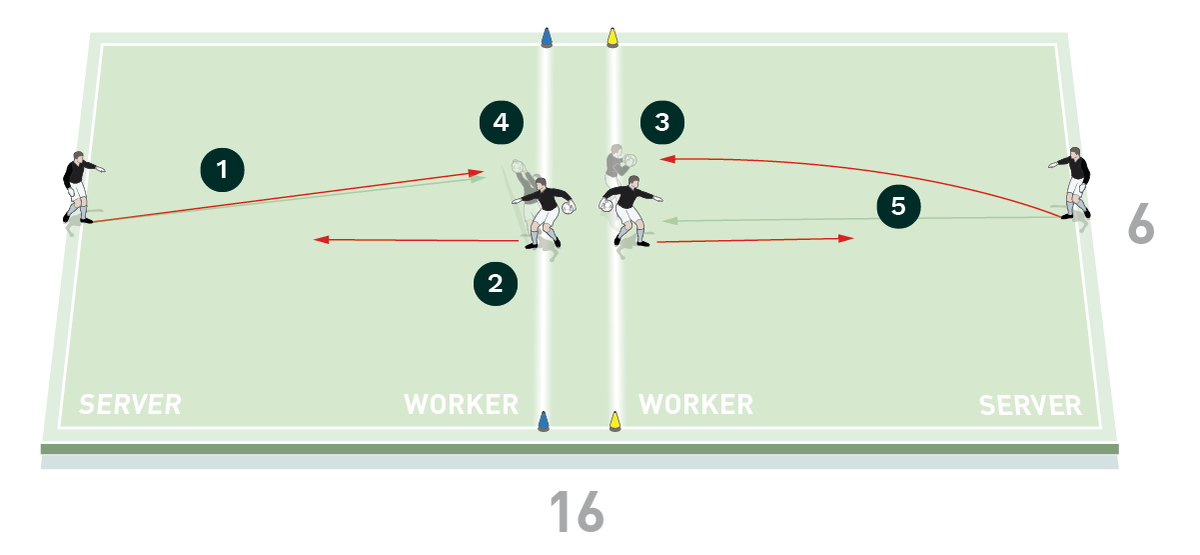
-
The goalkeepers work in pairs, with the serving goalkeeper on the edge of the area and the working goalkeeper on the inside
- The serving goalkeeper plays a driven strike to the working goalkeeper
- The serving goalkeeper catches the ball with their hands and returns the ball to the working goalkeeper
- The working goalkeeper catches the ball with their hands and returns the ball to the serving goalkeeper
- The working goalkeeper volleys the ball to the serving goalkeeper
The server can then [1b]:
- Take two touches to control and shoot, allowing the working goalkeeper to work on handling or blocking
- Take one big touch to engage 1v1, allowing the working goalkeeper to work on spreading or smothering
- Take one small touch and look to hit the cones, allowing the working goalkeeper to work on handling low and close, or a foot save.
[1b]
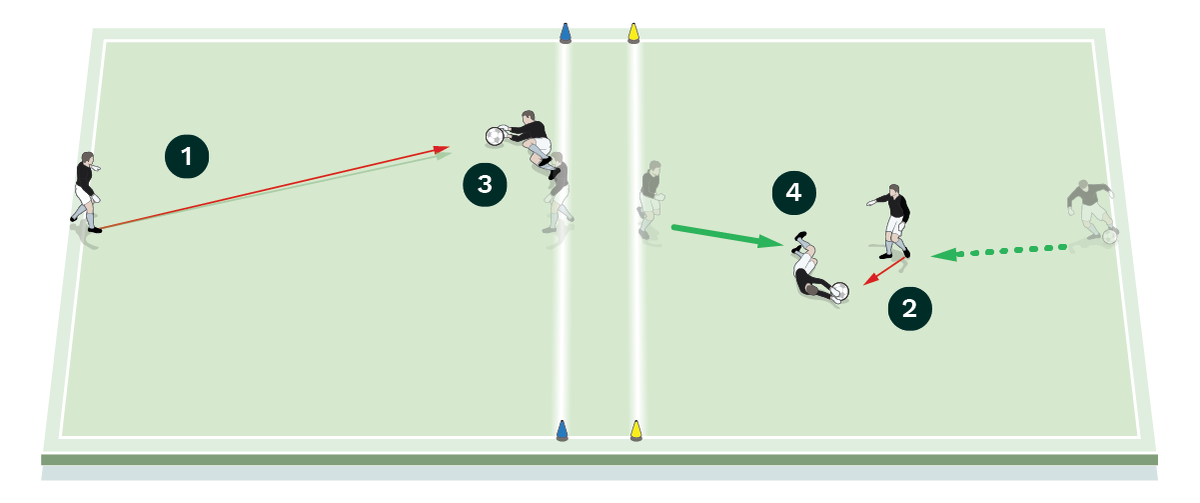
-
The working goalkeeper takes a small touch, then looks to hit the left hand blue cone
- The working goalkeeper takes a big touch and engages 1v1
- The serving goalkeeper dives to save
- The serving goalkeeper gets down low and spreads themself to make a save
“The serving goalkeeper will play the ball into the working goalkeeper in four different ways: volley, half volley, side-foot strike and driven strike”
The goalkeepers interchange so they get a chance to be both working keepers and serving keepers.
SEMI-LIVE PRACTICE
Working in the same area as the activation, this practice is a progression. A coach (or another player) comes in as a bounce pass to the serving goalkeeper.
Both serving goalkeepers start with a ball. The position of the ball should be varied to work on the serves used in the technical-focused activation. Both working goalkeepers start with a ball on the floor.
The coach calls a colour, and the goalkeeper working in that colour passes the ball to the coach – they become the ‘active’ side. They work relative to the ball. Once the coach passes to the server, the working goalkeeper either spins to protect the goal or engages 1v1 [2a].
[2a]
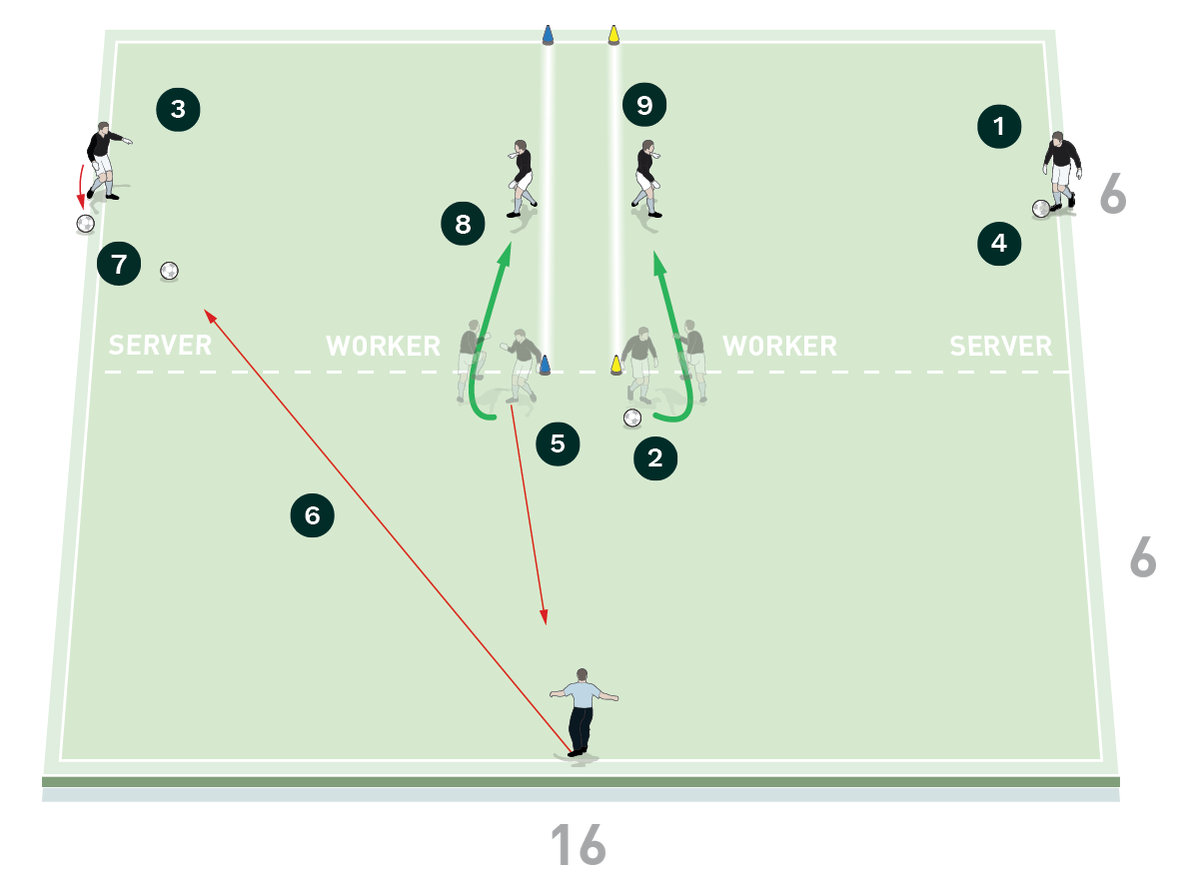
-
The goalkeepers work in pairs, with the serving goalkeeper on the edge of the area and the working goalkeeper on the inside
- Both working goalkeepers start with a ball on the floor, facing the coach
- The serving goalkeeper starts with a ball in hands
- The serving goalkeeper starts with a ball on the floor
- The coach calls blue and the working goalkeeper next to the blue cone passes the ball to the coach, making the blue side the ‘active’ side
- The coach passes the ball to the blue server
- The blue server drops their ball to receive the new one
- The working goalkeeper spins to protect the goal
- The working goalkeeper spins into the goal
The server who receives from the coach is on a one-touch finish. The opposite colour works on spinning into the goal for a serve used in the warm-up [2b].
[2b]
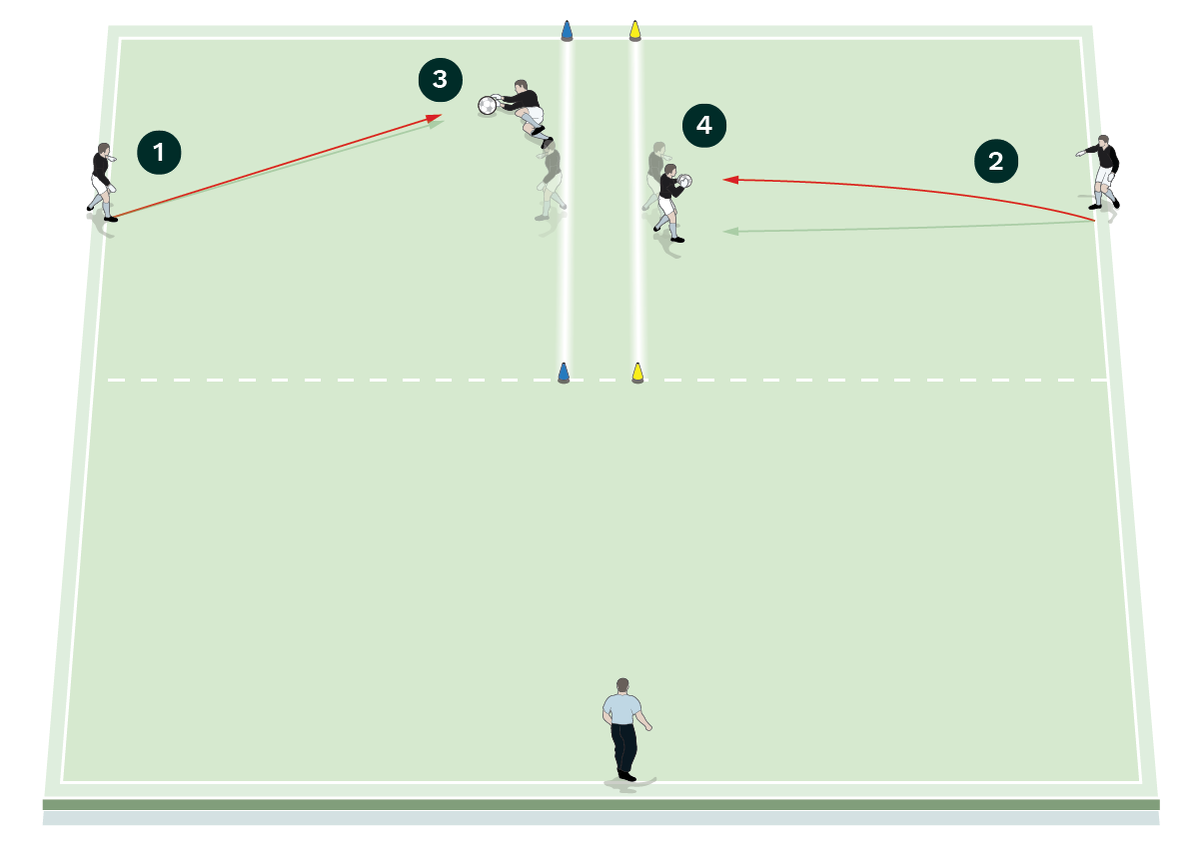
-
The serving goalkeeper on the blue side looks to finish one touch
- The serving goalkeeper on the yellow side volleys the ball
- The working goalkeeper gets down to save
- The working goalkeeper catches
“The position of the ball should be varied to work on the serves used in the technical-focused activation”
The goalkeepers interchange so they get a chance to be both working keepers and serving keepers.
We run this practice and the technical-focused activation for a total of 20 minutes.
SSG
We’re using an area 24 yards long and 28 yards wide, with a four-yard square in each corner and a full size goal at each end. The area is located around the six-yard box.
We’re using four goalkeepers in two teams. One goalkeeper from each team starts in goal, the other in their designated box.
The coach starts the practice by serving to any of the goalkeepers. If the coach plays to a goalkeeper in goal, this player must shoot at the other goal. Once the goalkeeper makes a save, the practice becomes live as a 2v2.
A caught save results in a 2v2 no restrictions game or a direct strike to the opposition goal [3a].
[3a]
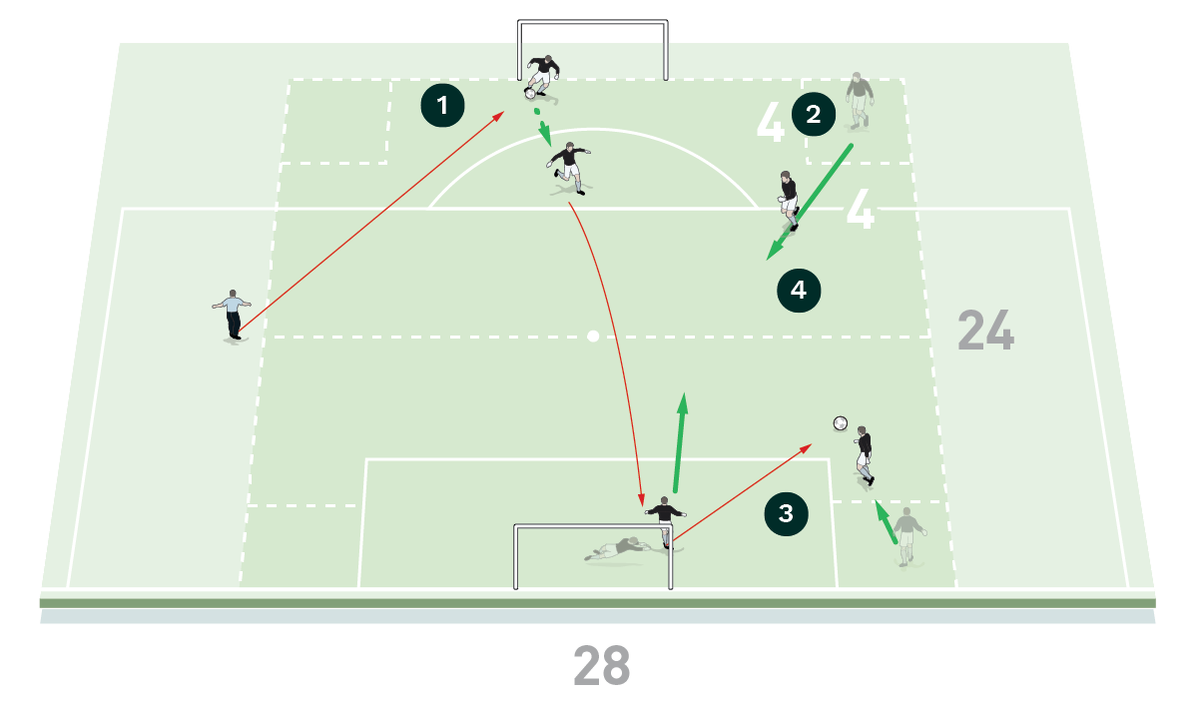
-
The coach serves to a goalkeeper in goal
- The goalkeepers work in pairs, with one in each pair in goal and the other in one of the boxes
- The goalkeeper shoots at goal, the opposite goalkeeper makes a save by catching the ball
- The practice becomes an unrestricted 2v2
A parry means this goalkeeper’s team-mate is locked in their box, but the opposition are both free to attack, meaning it’s a 2v1 [3b].
[3b]
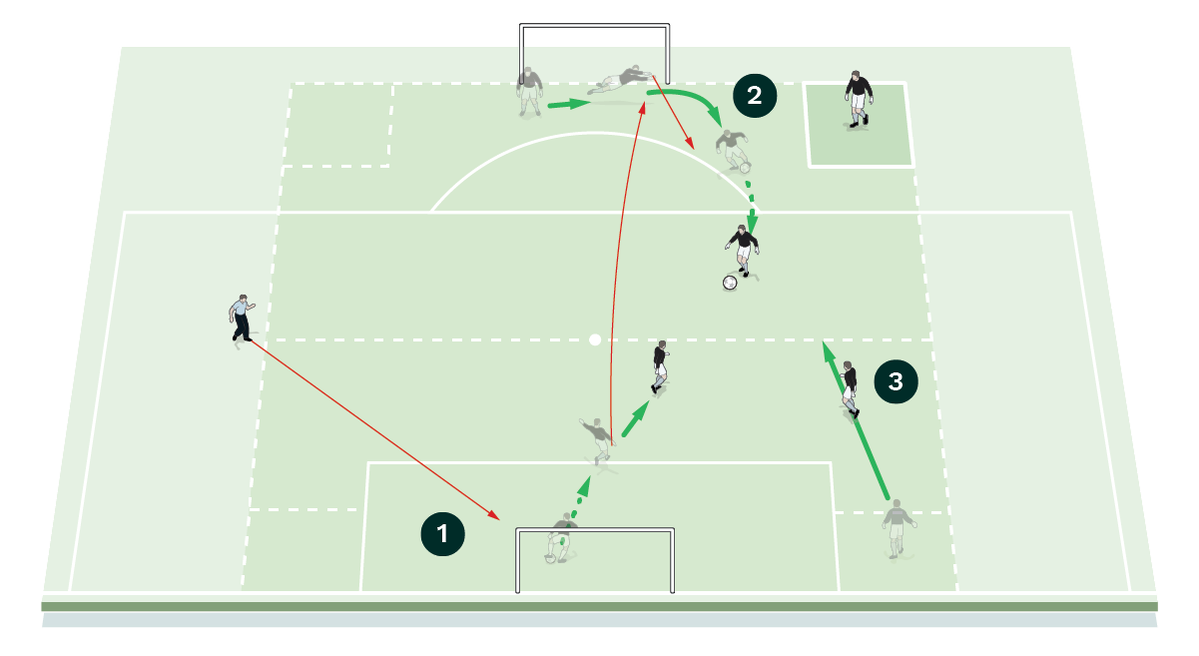
-
The coach plays the ball to the other goalkeeper in goal
- This goalkeeper shoots and the keeper makes a parry save, meaning their team-mate is locked in his box
- The practice becomes a 2v1
If the coach plays to a goalkeeper in a marked box, this player can play a one-touch pass for their partner to try and score. This allows the opposite goalkeeper to work on their choice based on distance from the goal, the opponent being in control of the ball or not, and whether they should engage or hold to defend the goal [3c].
[3c]
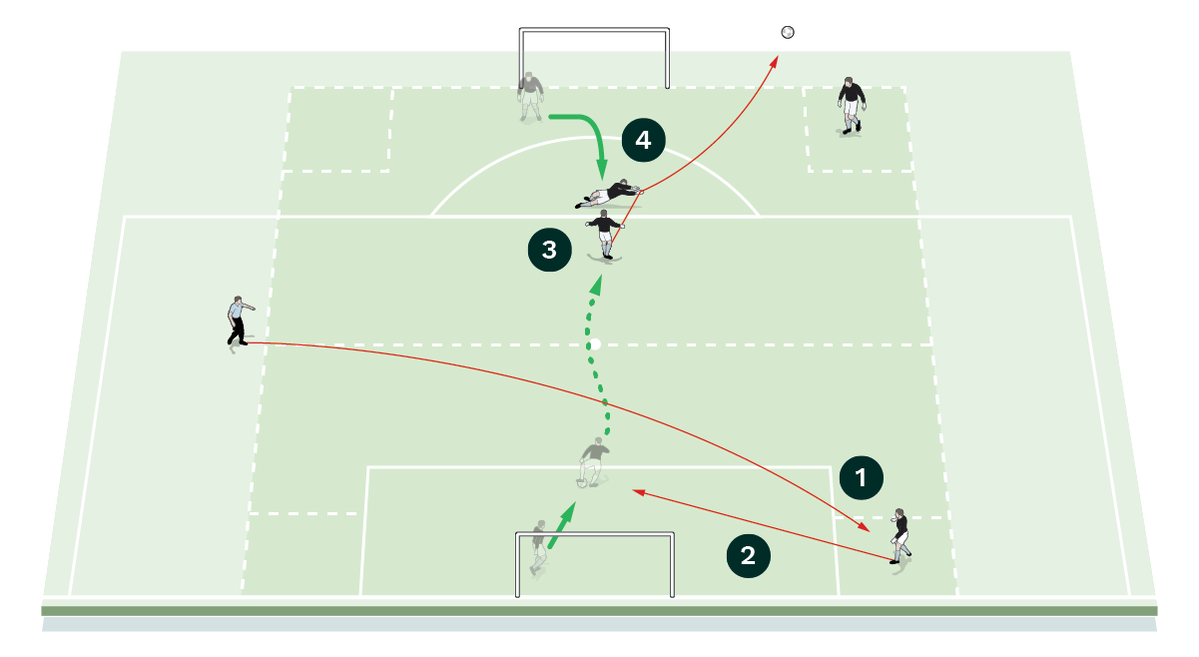
-
The coach plays the ball to a goalkeeper in a marked box
- The player plays a one-touch pass to their partner
- The goalkeeper looks to score
- The opposing goalkeeper comes out to close the ball down
Or, the player in the box can take two touches to receive and look to shoot at the opposition goal –
the game then becomes a 2v2 game [3d].
[3d]
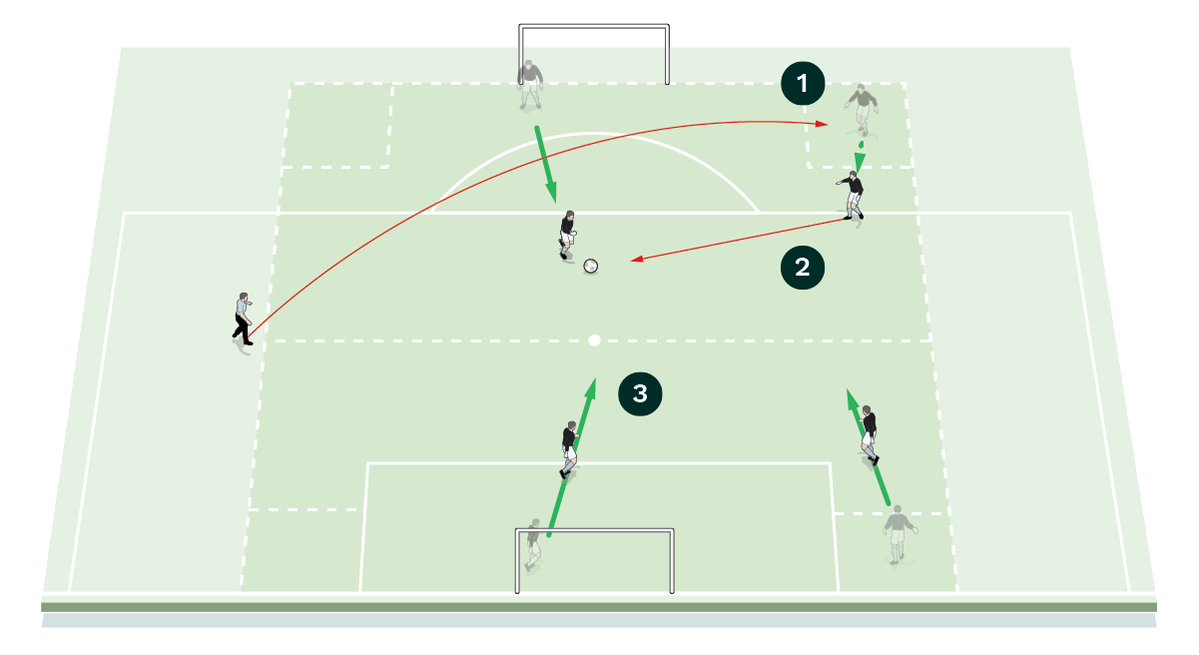
-
The coach plays the ball to the other goalkeeper in a marked box
- This player takes two touches
- The game becomes a 2v2
The game resets when the ball leaves the area or a goal is conceded. A points system is used to determine the winner based on amount of goals and number of saves.
Goalkeepers should interchange positions to work different elements of the practice.
We run this practice for 40 minutes.
This session can be adapted to include outfield players with more goals, or by adjusting the pitch size and shape. Maybe adapt a triangular pitch and add a third goal to add an element of angled shot stopping or transitions from another area of the pitch.
You could also use the halfway point as an offside line, or mannequins for an added element of distraction and variation of the movements associated with the topic.
It can also be expanded to include a full team practice which, for example, looks at defending the space outside of the 18-yard box.
This session is suitable for all ages and abilities. Keep it simple but allow for as many realistic outcomes as possible.
Allow the goalkeepers to explore what works for them in each scenario. I have five goalkeepers in the professional development phase and all of them have their own ‘best way’ to deal with this session.
Chaos and ‘messy’-looking sessions are great for allowing the goalkeepers to make decisions!
COACHING POINTS
What are the key things to look for?
Technically, in possession, we’re looking for body position to receive and release a pass and ball striking, short or longer.
Out of possession, we’re looking for body shape and position when setting, moving and engaging.
Tactically, in possession, we’re looking for:
- The ability to support away from the ball and know the next available pass
- The ability to work on transitional movement and to recognize transition moments
- Positioning in goal and in the area
- When to engage or hold in the goal, depending on what is most effective for that individual
- What technical choice is most effective in a particular engage moment: whether it’s spread, block or smother, left or right hand, or a certain hand position
- Communication, particularly in the SSG. We want players to work together with their partner to attack and defend efficiently and effectively.
What are the typical mistakes players might make and how do I avoid them?
There are no mistakes in this session. Every action has a suitable outcome for the goalkeepers. The key to this is providing a clear understanding of the conditions of the SSG.
Related Files
Editor's Picks
Attacking transitions
Deep runs in the final third
Using the goalkeeper in build-up play
Intensive boxes drill with goals
Penetrating the final third
Creating and finishing
My philosophy
Pressing initiation
Compact team movement
Coaches' Testimonials

Alan Pardew

Arsène Wenger

Brendan Rodgers

Carlos Carvalhal

José Mourinho

Jürgen Klopp

Pep Guardiola

Roy Hodgson

Sir Alex Ferguson

Steven Gerrard
Related
Coaches' Testimonials

Gerald Kearney, Downtown Las Vegas Soccer Club

Paul Butler, Florida, USA

Rick Shields, Springboro, USA

Tony Green, Pierrefonds Titans, Quebec, Canada
Join the world's leading coaches and managers and discover for yourself one of the best kept secrets in coaching. No other training tool on the planet is written or read by the calibre of names you’ll find in Elite Soccer.
In a recent survey 92% of subscribers said Elite Soccer makes them more confident, 89% said it makes them a more effective coach and 91% said it makes them more inspired.
Get Monthly Inspiration
All the latest techniques and approaches
Since 2010 Elite Soccer has given subscribers exclusive insight into the training ground practices of the world’s best coaches. Published in partnership with the League Managers Association we have unparalleled access to the leading lights in the English leagues, as well as a host of international managers.
Elite Soccer exclusively features sessions written by the coaches themselves. There are no observed sessions and no sessions “in the style of”, just first-hand advice delivered direct to you from the coach.
